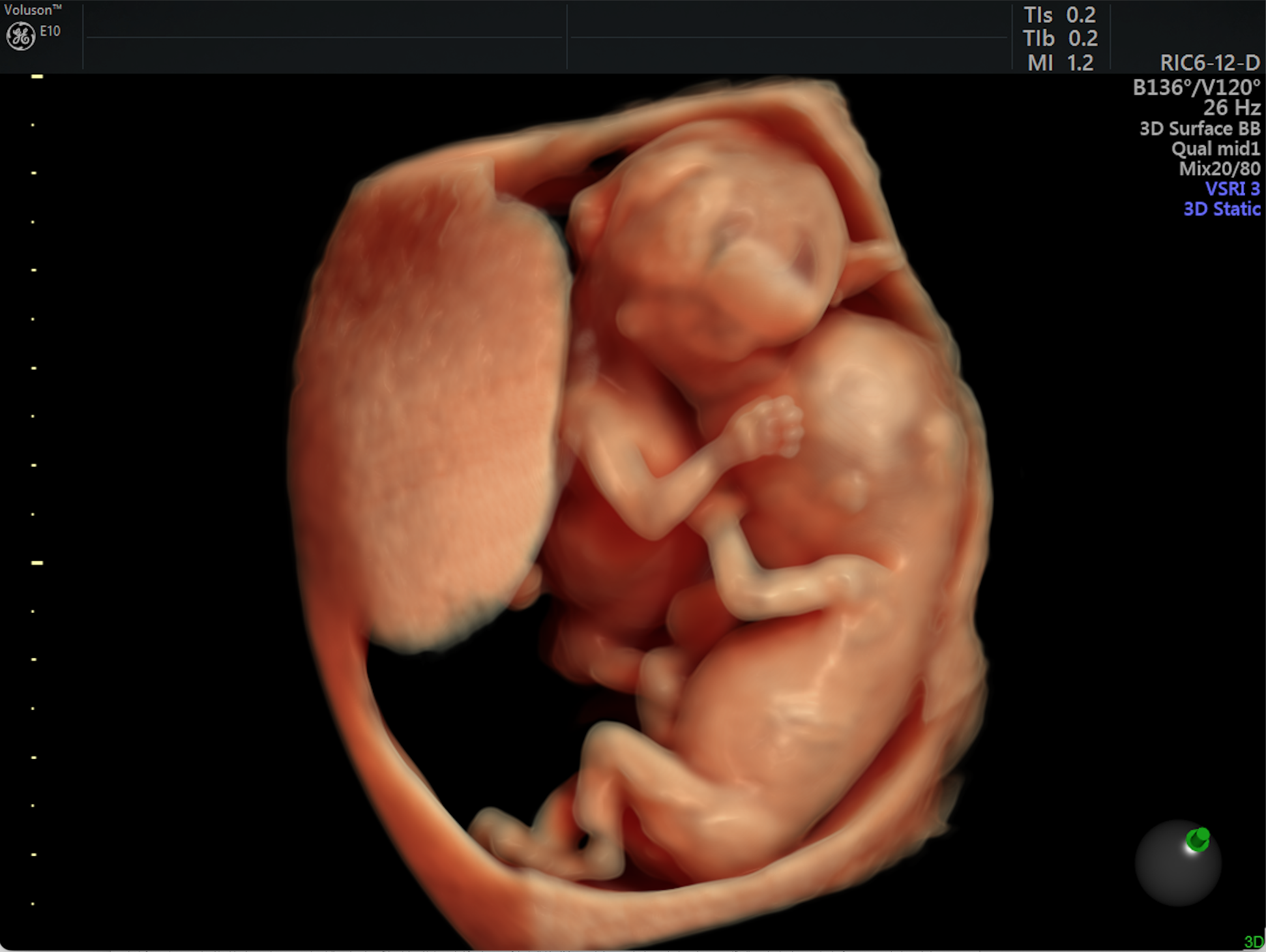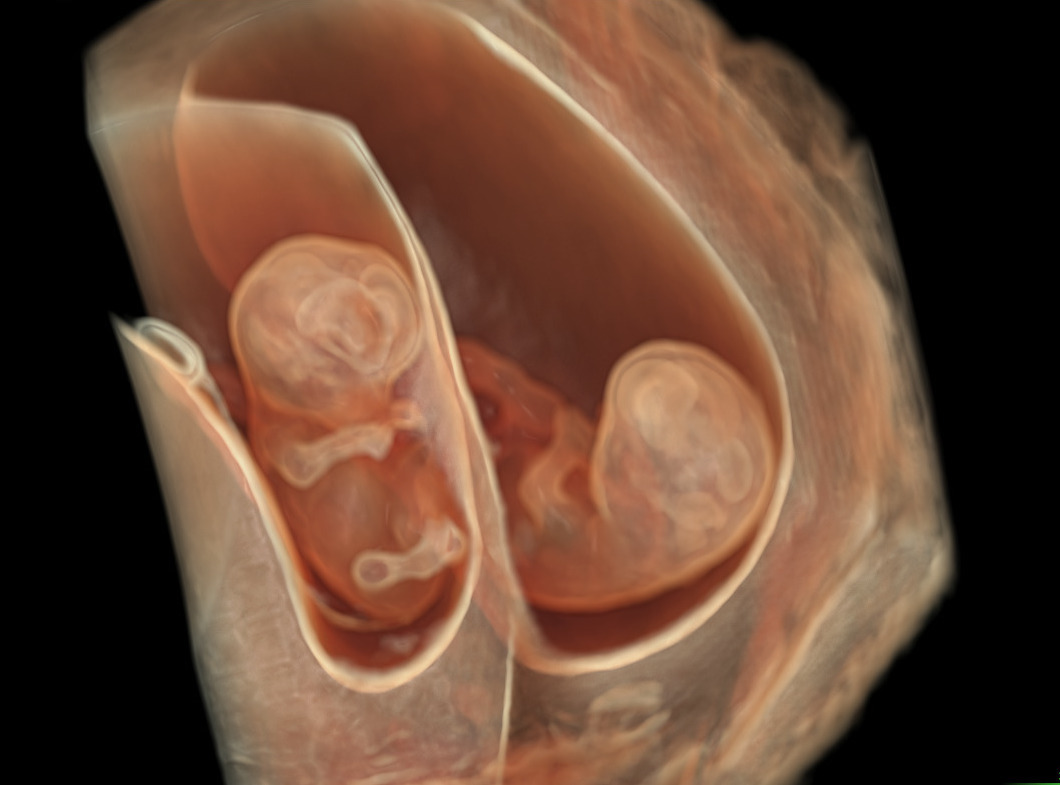Compared with singleton pregnancies, twin pregnancies are subject to more complications and poorer outcomes. This makes it crucial to identify twins during prenatal monitoring. But what are the different types of twins?
For all presentations of monochorionic and dichorionic twins, routine ultrasound monitoring throughout pregnancy is key for maternal and fetal health.
Monochorionic vs. Dichorionic Twins
The complications associated with a twin pregnancy will depend on the type of twinning that is present.
Monochorionic twins are identical twins who have developed from a single sperm that fertilized a single oocyte; the embryo splits early in development, resulting in two identical fetuses. Dichorionic twins are fraternal twins, which develop from two different oocytes that were fertilized by two different sperm. Each becomes a unique embryo that matures into an individual fetus.
Monochorionic twinning can occur spontaneously in approximately 0.4 percent of the general population, according Obstetric Imaging: Fetal Diagnosis and Care. However, a study published in the Journal of Assisted Reproduction and Genetics found that fertility treatment can increase the number of monozygotic pregnancies by a factor of 10.
The occurrence of dichorionic twins varies widely, influenced by several key factors:
- Advanced maternal age
- Maternal BMI
- Past maternal parity and family history, including previous twin pregnancies
- Multiple ovulations within one menstrual cycle due to higher levels of follicle stimulating hormone and luteinizing hormone
Rates of dichorionic twins also show unusual racial and ethnic variation. Dizygotic twins occur in 1.3 out of every 1,000 births in Japan but in 50 out of every 1,000 births in some parts of Nigeria, according to StatPearls.
What Are the Different Types of Twins' Common Pregnancy Complications?
All twin pregnancies require increased monitoring, but monochorionic twins need especially close supervision. The majority of twin pregnancy losses occur in monochorionic twin pregnancies within the first 24 weeks of gestation. Perinatal morbidity of monochorionic twins is between two and four times higher than for dichorionic twins, reports research published in Maternal-Fetal Medicine. Determining the chorionicity of all twin pregnancies via ultrasound is a critical part of the prenatal assessment that allows physicians to detect and prepare for possible complications early on.
Monochorionic fetuses share a single placenta, which can result in an unequal distribution of nutrition and blood flow via the umbilical cords. In some cases, twins may grow within one shared amniotic sac. These are called monoamniotic twins, and this type of pregnancy can also lead to complications.

12 week monochorionic twins seen on Voluson™ ultrasound
Dichorionic twins, on the other hand, each develop their own placenta, and diamniotic twins have separate amniotic sacs. This results in fewer growth and nutrition issues.

9 week dichorionic twins seen on Voluson™ ultrasound
What Maternal and Fetal Risks Are Associated With Twins?
All pregnancies come with maternal and fetal risks. For multiple pregnancies, the risks likewise multiply. The pregnant parent also faces an increased risk of complications during the prepartum, partum and postpartum periods, including abnormal vaginal bleeding (both during pregnancy and after delivery), preterm labor and preeclamsia.
Twins are more frequently delivered by cesarean section than singletons. A C-section can prevent perinatal morbidity in monoamniotic pregnancies by reducing the risk of umbilical cord entanglement. When the umbilical cords are knotted in utero, it can result in a reduction or elimination of blood flow to one or both twins, causing distress and even death. The risk of the cords becoming tangled is much higher for monamniotic and monochorionic twin pregnancies.
Even uncomplicated twin pregnancies may benefit from a planned cesarean section to reduce the risk of complications during delivery. This is usually timed at 37 weeks for monochorionic twins and 39 weeks for dichorionic twins, according to research published in the British Medical Journal.
How Can Ultrasound Assist in Spotting Complications?
Twin pregnancies are subject to higher levels of perinatal mortality. In monochorionic twin pregnancies, mortality mainly occurs due to occurrences of fetal growth discordance or twin-to-twin transfusion (TTTS) with acute polyhydramnios. Research published in Prenatal Diagnosis points out that an early sign of TTTS may be differences in growth and differences in the crown-rump length (CRL) between the twins in the first-trimester ultrasound scan at 11-14 weeks gestation.
Other fetal complications in a twin pregnancy can include low birth weight and preterm birth. A study from the American Journal of Obstetrics and Gynecology revealed that the best predictor of spontaneous preterm birth is when the cervical length measures less than 25 mm at 24 weeks gestation during a twin pregnancy ultrasound exam.
Another risk in twin pregnancy is velementous cord insertion (VCI), which describes an umbilical cord that inserts on the edge of the placenta and is not protected and cushioned along its full length. In up to 40 percent of twin pregnancies, at least one fetus is found to have a VCI, reports research from the Journal of Clinical Medicine. The resultant unequal placenta sharing or anastomosis of the vessels can cause discordant growth rates between twins, and was previously believed to cause perinatal death. Fortunately, the cord insertion can be readily assessed via ultrasound.
Utilizing First Trimester Ultrasound for Twin Pregnancies
Both transabdominal and transvaginal ultrasound exams are valuable for assessing and monitoring twin pregnancies. This radiation-free, widely available imaging modality allows for frequent examinations at minimal risk to patients and fetuses.
A provider should perform a first trimester ultrasound exam between 7-14 weeks of gestation. At this stage, the exam can identify one or two fetal poles with cardiac activity. The physician should also measure the length of both fetal poles for the CRL and compared for any discrepancies that could indicate a risk for miscarriage.
Next, they should identify the placenta and membrane between the two fetal poles. If there are two clearly separate placentas present, then the pregnancy is dichorionic. When two placentas are fused together or located so closely together as to appear fused, there will be a wedge-shaped junction visible somewhere between the two fetal poles, referred to as the "lambda" sign. This is where the chorionic tissue has extended into the inferior part of the membrane between the two twins, also proving that a twin pregnancy is dichorionic.
If ultrasound reveals a single placental mass without the presence of a lambda sign, twins can be designated as monochorionic. In this case, a thinner membrane with a "T" sign may be visible, indicating two amniotic sacs (monochorionic diamniotic). Or, the membrane may be absent completely, indicating that both fetuses are developing within one shared amniotic sac (monochorionic monoamniotic).
Once a twin pregnancy has been determined to be monochorionic, an OB/GYN should pay close attention to any signs of discordant growth of the twins or discordant volumes of amniotic fluid. In some situations, repetitive assessment of the anatomy of both twins may be required to detect any possible signs of complication or abnormality.
Guiding Monochorionic vs Dichorionic Ultrasound Assessments
Per the ISUOG Guidelines for Twins, the presence of either the "lambda sign" or "T sign" on ultrasound predicts chorionicity with a very high degree of accuracy, prior to 14 weeks gestation. To identify which of these signs is present, the pregnancy must be assessed between 7-14 weeks gestational age, with a focus on the area of the chorionic and amniotic membranes at the junction where the two twin gestational sacs meet within the uterus.
The "lambda sign" represents the triangle-shaped projection of chorion between the layers of inter-twin membranes. This is so named because its appearance resembles the "lambda" (λ) character in the Greek alphabet. When present it indicates that a dichorionic diamniotic twin pregnancy has developed. An alternate name for this is the "twin peak sign" referring to the appearance of a mountain peak where the fused dichorionic placenta appears as between the two gestational sacs.
Whereas the "T sign" is instead the absence of a lambda shape in the membranes between the two gestational sacs. This is because there is only one layer of chorion present, which indicates a monochorionic pregnancy. Where the membranes meet there is a distinct "T" shape indicating the presence of a "T sign".
A second sign that can help differentiate between a monochorionic and diamniotic twin pregnancy on ultrasound is the sex of the twins. When both twins are of the same sex, they can be either monochorionic or diamniotic. Twins that are of different sexes can only be dichorionic. However, determining the sex using ultrasound is only possible in the second and third trimesters, as the genitalia is not visible until that stage of growth.
Differentiating between a dichorionic and monochorionic twin pregnancy helps OB/GYNs mitigate the higher risk of early pregnancy loss and complications associated with monochorionic pregnancy. Early detection of complications in monochorionic twins can help foster the best possible outcomes for both parents and children.





